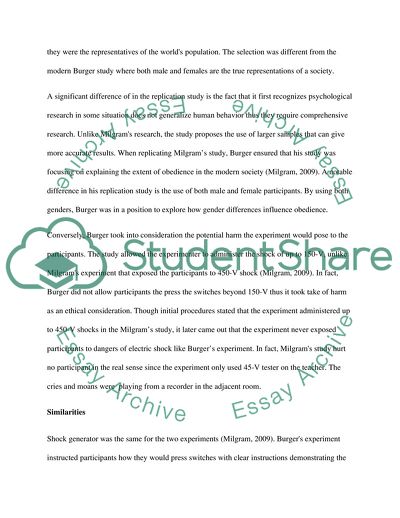Cite this document
(Similarities and Differences between Milgram's (1963) Obedience and Burger's (2009) Replication Essay Example | Topics and Well Written Essays - 1250 words - 1, n.d.)
Similarities and Differences between Milgram's (1963) Obedience and Burger's (2009) Replication Essay Example | Topics and Well Written Essays - 1250 words - 1. https://studentshare.org/psychology/1856080-outline-the-similarities-and-differences-between-milgrams-1963-obedience-study-and-burgers-2009-replication
Similarities and Differences between Milgram's (1963) Obedience and Burger's (2009) Replication Essay Example | Topics and Well Written Essays - 1250 words - 1. https://studentshare.org/psychology/1856080-outline-the-similarities-and-differences-between-milgrams-1963-obedience-study-and-burgers-2009-replication
(Similarities and Differences Between Milgram's (1963) Obedience and Burger'S (2009) Replication Essay Example | Topics and Well Written Essays - 1250 Words - 1)
Similarities and Differences Between Milgram's (1963) Obedience and Burger'S (2009) Replication Essay Example | Topics and Well Written Essays - 1250 Words - 1. https://studentshare.org/psychology/1856080-outline-the-similarities-and-differences-between-milgrams-1963-obedience-study-and-burgers-2009-replication.
Similarities and Differences Between Milgram's (1963) Obedience and Burger'S (2009) Replication Essay Example | Topics and Well Written Essays - 1250 Words - 1. https://studentshare.org/psychology/1856080-outline-the-similarities-and-differences-between-milgrams-1963-obedience-study-and-burgers-2009-replication.
“Similarities and Differences Between Milgram's (1963) Obedience and Burger'S (2009) Replication Essay Example | Topics and Well Written Essays - 1250 Words - 1”. https://studentshare.org/psychology/1856080-outline-the-similarities-and-differences-between-milgrams-1963-obedience-study-and-burgers-2009-replication.


